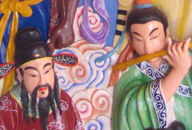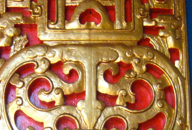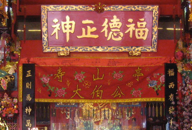Tua Pek Kong Temple
KUCHING, SARAWAK
EAST MALAYSIA, BORNEO
APRIL 21, 2009


Tua Pek Kong Temple
KUCHING, SARAWAK
EAST MALAYSIA, BORNEO
APRIL 21, 2009




In the center of Kuching, near the Sarawak River, stands a brightly colored Buddhist Temple, the oldest in the city. Believed to have been built in 1843, official records recognize its existence dating from 1876. This temple has followed the traditions of the Chinese citizens of the city, and continues to be an active center of worship. This is where the community pays homage to the Tua Pek Kong, the deity for peace and prosperity. Henry and I witnessed a dragon dance of two long dragons, their interplay choreographed and manned by two groups of school lads. Each team was clad in opposing colored polo shirts, all clashes enacted at the gate of the temple. Just across the street from this colorful temple is the Main Bazaar, with some superb examples of shophouses built in the traditional Chinese architecture. Across the street, facing the river, stands the Chinese History Museum, a pale pink structure originally built in 1912 as a courthouse for Sarawak’s Chinese community. In 1930 it became the Chinese Chamber of Commerce, then in 1991, was converted to a museum. The museum traces the initial trade routes and the geographical distribution of the early pioneers. The Chinese were welcomed as immigrants during the reigns of the white rajas, which encompassed a 100 year period. Story boards in this museum recount the history of these early immigrants who traveled to Sarawak aboard Chinese junks, their passage, described as extremely difficult, with the journey’s conditions having been cramped and miserable. In its exhibits the Chinese History Museum tells the story of early immigration, and the Chinese community’s involvement in multi-racial Sarawak.
PHOTOS: Left Column: 1. Tua Pek Kong Temple. 2. View of the beautifully carved retaining wall supporting the temple. 3. Detail: colorful temple decorations in porcelain. 4. Detail: decorative temple carving. Center, Top: A delicate painting on a wood panel in the temple. Center, Bottom: A painted panel in the temple. Right Column: 1. Colorful tiles and carved retaining wall upon which Tua Pek Kong temple rests. 2. Doorway framed by temple paintings. 3. Detail: colorful temple decorations in porcelain. 4. Detail: temple altar.


CITY’S CHINESE ENCLAVE






